
| Next Blog Page | ||||
| January 19, 2010 | ||||
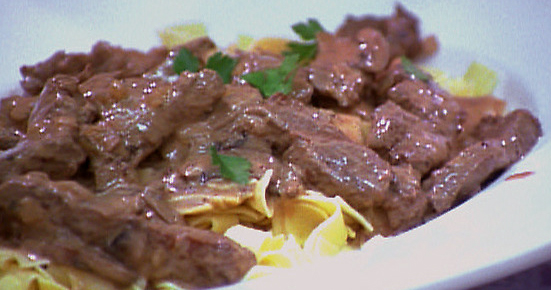 |
Back in the Saddle..... | |||
| ....So the horse
nut got back on the torch last night after several weeks off (it's cold
in the outer reaches of the Grotteaux where the torch is!) and made her
first horsehead of 2010. She's its mother so she loves it, but it won't
see the light of a sales table. However, some progress was made, in adding
amber transparent eyes to it. Much like the the main torchmaster's glass
eyeballs, adding eyes to a sculptural figure brings it alive. Suddenly
there's an expression and a personality. You'd swear it could talk. And if it could, this one would've said, "Well, are you going to leave my nose all melted like that, then?" It probably would've sounded like it had a cold, too. Anyway, the nose was repaired, the mane was prettied up and this one will stay in the Grotteaux's private stable. But, more TK! And one reason that the horse nut had time to do this is because dinner had been started early. Who doesn't love coming out of the cold grotteaux into a warm house to be greeted by the aroma of something great in the oven? Here's what it t'was: CRANBERRY-PORT POT ROAST "You need a recipe for that?" the torchmaster said as the horse nut was madly leafing through cookbooks and looking on the Internet for the recipe when she couldn't find it. There had been a recipe in an old Sunset magazine recipe annual, but it seems that that issue was given to the library book sale in a fit of bookshelf-cleaning. Anyway, the original official recipe had pearl onions in it, which we didn't have, and probably a lot more brown sugar. Memory fails. But this recipe doesn't. Pot roasting is a method used on those cheaper cuts of beef that are too tough to grill. Choose a cut that's call pot roast, 7-bone roast, or chuck roast (of any kind). This is another one of those flexible methods of cooking. It's the kind of dish you would've put together in cookfire days and either buried in the embers or set off to the side in a big fireplace or stone oven. What I'm saying is, you can cook a pot roast at 250 degrees or 400 degrees, and, except for having to watch it under the higher heat so the liquid doesn't completely cook away, it'll come out fine. In this case, we took one of these roasts, weighing about 3 pounds, and threw it into a covered shallow pot on top of half a finely chopped onion and one small chopped carrot. (You could also add other "aromatic" vegetables such as chopped celery or bell pepper here -- garlic, too.) At the bottom of the pot: about 1/4 cup olive oil. We peppered and Mrs. Dashed the top of the roast, added some garlic and onion powder just because we felt like it, and put it in a preheated 400-degree oven, uncovered, for about 30 minutes: that is, 15 minute per side. This gives the roast a good browning. Then we threw in a half-cup of port, a half-cup of white wine and a 15-ounce can of beef broth, put the cover on the pot and set the heat at 200 for a couple of hours. At that point, we threw in a bag of cranberries left over from Thanksgiving. (Note: You always need to put the cranberries in a colander and go through them to remove the soft ones, then rinse.) We added about 1/4 cup brown sugar, too, and stirred that in. The cover went back on the pot and the roast was left in th oven for another hour. Since we were concerned that it wouldn't be completely done, we raised the temperature again to 350 degrees. Now. You can also do this in the crockpot (probably on Low for 6-7 hours or whatever the instructions with yours suggest for pot roast). You don't absolutely have to brown the roast, but we like the flavor and color better when we do. You can add little whole onions if you like -- bagged and frozen or fresh, if you have the time to trim and peel them. Serve over cooked starch of choice, if you do starch (one of us does, the other doesn't). Especially good: egg noodles. |
||||
| January 14, 2010 | ||||
 |
Ok, we got
so much mail... ... about that “cooking on your engine block” |
|||
| entry that it darned
near overflowed the virtual mailbox and flooded two of the virtual caverns.
And a lot of it talked about the “cooking salmon in the dishwasher”
recipe. Now, I’ll grant you, there is probably no sensible reason
for doing this, but, then again, why should that ever stop anyone.....? It did prod us into doing some searching of our own, just in case our kitchen is rendered inoperable by a crumbling stalactite again. (The last time that our kitchen was re-worked it was a rather complete job, and we did a lot of “camping in our own home” sort of cooking, including making the morning coffee “a la Coleman,” and a heckuva lot of barbecuing. My old, old, old Boy Scout Handbook was even pressed into service, bringing back some terrific memories of cooking biscuits on a stick, which wowed the kids (who had thought that I was putting them on about it.)) This number came up from, to our wondering eyes, a supplier of appliance parts: hard to believe...... |
||||
| January 8, 2010 | ||||
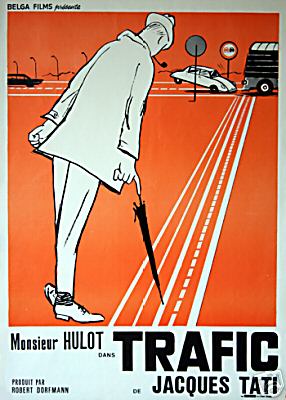 |
Had
a chance to watch the wonderful ... ... Jacques Tati film “Trafic” (ok, it’s in french) t’other day. |
|||
It’s always a joy to watch the lovable Mr. Hulot up to his antics. (Fans of “Mr. Bean” will love him, too.) His last film, "Trafic” is marginally about taking (or trying to) Hulot’s latest car design, a sort of campmobile, to a car show. There are some throwaway shots of the car being converted into its various configurations, including bumpers that pull out into seats and the front grill that converts to a, well, grill, of course. It got me to thinking about some old Popular Mechanics magazines (from the late 1940s) that used to float around the art department at one of the community colleges that I attended many long years ago. These magazines had the first examples I ever saw of cooking on the exhaust manifold of your car (which, when written, had engine compartments the size of a bistro, anyway.) They were pretty funny, despite their earnestness, giving some good meat loaf recipes and describing how to cook chicken for something like 75 miles on a side. (Remember, this far pre-dated any such thing as franchised food, and motels were known as “Motor Courts”....) Our beloved, indispensable web is now rife
with such recipes (even though today’s engine compartments can
hardly accommodate a couple of Vienna sausages), sometimes referred
to as “Carbecue,”
to wit:"The
Heat Is On"and a segment
from "Real
Food" |
||||
| January 3, 2010 already! | ||||
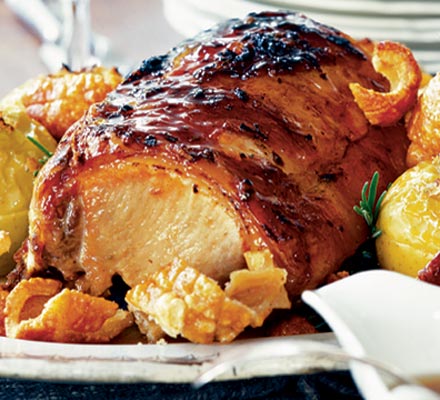 photo courtesy of bbcgoodfood.com |
Holy
cow,... ... we just poked our head up out of the Grotteaux |
|||
| and, well, it’s
a whole new year out there! WEBERED PORK ROAST The thing here about studding the roast
with garlic is that one of us doesn’t tolerate the stinking rose
well, although loving the taste. Combining the herbs with the garlic
marks the spot so the cloves can be avoided, and yet flavors the nearby
meat in an acceptable manner. [The Ralph: this is not only greatly appreciated
by me, but by friends, neighbors and everyone downwind] 1 pork butt or shoulder roast, 3+ pounds Take the roast out of the fridge a couple of hours before starting the charcoal fire. It will cook faster and more evenly if it starts out at room temperature (but be sure to park it somewhere that the resourceful and motivated dog can't reach......) Separate the garlic head into cloves, smash
the cloves with the side of a knife and remove the skins, then cut into
slivers (about a half or a third of each clove). With the point of a sharp knife, cut slits into the roast at intervals all over the surface -- depth doesn’t matter that much, but mine tend to be 1-1-1/2 inches. Grab a garlic sliver and about the same size wad of herbs and poke into each slit until the garlic is used up, the roast is evenly studded, or when you get bored, whichever comes first. (Particularly rabid garlic lovers will probably have something resembling a hedgehog at this point.) Start a charcoal fire on the charcoal grate with enough briquettes to last 2-3 hours (check the bag). When the coals are about 75 percent covered in gray ash, separate them into two piles opposite each other. The idea is to make a space so the roast is not directly over any coals -- this is indirect charcoal grilling. Place the roast on the grilling rack, over
the empty space. You can put a drip pan under the roast, although we
usually just let the meat drip into the ashes we haven’t cleaned
out of the thing. Add a few briquets occasionally, if it appears
necessary, but you don't really need an inferno. Our roast usually spends the last 10 or 15 minutes in the bbq with some of the prunings from our Golden Delicious apple tree tossed onto the fading coals, to add a delectable smokiness to it. (Since the tree has to get pruned every year, we have a giddily renewable resource, and it doesn't need to be composted or go to a landfill, yay!) Remove roast when it’s done and let rest for a few minutes before slicing. You’ll have dinner tonight, plus wonderful meat for sandwiches, pasta, omelets or whatever you like, for several more days. |
||||
| December 23, 2009 | ||||
 pic gleefully lifted from Physicsgeek.mu.nu thanks, folks! |
We
hope that you and yours... ... are as filled with Holiday Cheer as we are. |
|||
(We finally found
that cask of 'Special' Sarsaparilla that we had put away to age so long
ago; it's at least old enough to get married now!) See ya next year (which isn't all that far off) with more fun! |
||||
| December 17, 2009 | ||||
[The Deborah here] A few months without bead shows or sales ... stretch before us. We're looking forward to the |
||||
| downtime here at
the Grotteaux. Not only to recover from the fun-but-exhausting round of
setting up booths and tables, but to turn our attention to replenishing
our stock of offerings and coming up with new stuff. And to just read,
watch movies and take the dog out for long rambles. (Our dog has gotten
so tuned in to words like "walk" or "park" that now
we call these outings, "Taking the you-know-who for a you-know-what."
That will last until he figures those words out, too. We also can't let
him see us put on lace-up footwear, fill the green canteen or go anywhere
near his leash.) Me, I'm looking forward to creating more freeform beadwork featuring our lampwork focal beads. I especially like the idea of making lampwork glass discs to use as closures for bracelets and necklaces, so I'll be turning out more of those. Will I choose glass colors to complement the beads I want to work with, or choose a bead palette that goes with the glass discs? The answer: Yes! That's why I love freeform beadwork. I'm not a pattern kind of person. I love the look of precise patterns, but I'll leave them to other beaders. I suppose it's partly an attention-deficit thing, and partly because when you're doing a pattern and an inspiration for something different - another color, another stitch, a realization that this isn't a bracelet at all, but a necklace, that you're making - you have to ignore it. Whereas freeform is just a series of leaps from one inspiration to another. (Well, and figuring out how to needle your way out of a corner you've beaded yourself into sometimes.) If you're a beader and you think you can't do freeform but would like to try, there are some easy ways to experiment with the idea. Start with a small project, like a bracelet in peyote (or any stitch you're most comfortable with). Choose beads in three colors that go together (three shades of blue; black, white and red; three different metallics). Now start your pattern. Randomly change colors, but stay in the same stitch. (If you have trouble thinking randomly, just dump all three colors on your beading mat and pick them up without paying attention to what color they are.) Or, if you're confident with three or more kinds of stitch, use all the same color beads but change stitches every so often. (Having trouble deciding when to change? Set a timer for 5 minutes and change when it goes off. Or put on a Beatles album and change stitches with every song.) You may decide this really isn't for you. But if you find it fun and freeing, you'll also note your creative mind starting to percolate with ideas. How about changing bead sizes? Throwing in a pearl, a fire-polished bead, a stone chip or a charm every so often? One very cool thing about beading is that, unlike cooking, it's very hard to ruin the ingredients. If you don't like the result, cut the thing apart and use them for something else. You'll only be out thread, time and, if you're like me, sometimes a broken needle. Almost certainly connected to my beading approach, I'm also a proponent of trust-yourself-cooking (as you can tell from my other recipes), plus I'm still rebelling against have to measure every little thing when I wrote recipes as a food editor. Now my motto is, "Does it look like something you want to eat?" If yes, eat. If not, do something else with it until it does look like something you want to eat. So, in that spirit, here's a recipe for: CHICKEN PICCATA This is our version of the classic veal dish. Overview: This is sauteed chicken breasts with a sauce of white wine, finished with lemon juice and garnished with capers. Ingredients (in the order you will use them): 2-3 tablespoons butter 2-3 tablespoons olive oil Chicken breast fillets (bought that way or cut them yourself): about 6 ounces per person (OK, I did throw a measurement in there) Flour Salt and pepper White wine A fresh lemon Capers In a large saute pan, melt the butter and olive oil on low heat while you prepare the chicken breasts for sauteeing. Flatten the chicken breasts (so they'll saute faster), using a meat mallet, the edge of a dinner plate or an empty wine bottle.[you could also use the side of a nearby husband's head, if he won't stay out of the kitchen....] Dredge the chicken breasts in flour until they're well coated. Heat the melted butter and olive oil until it sizzles a bit when you sprinkle a tiny bit of flour in the pan. Add the chicken breasts. When the edges start to whiten, season with salt and pepper. When the bottom of the meat has cooked enough so that it doesn't stick to the pan, turn it over. (If your pan doesn't fit all the breasts, do this in two batches. You don't want to crowd the chicken breasts or they won't brown properly. Once both batches are done, return all the breasts to the pan.) By now the flour will have just browned -- don't let it burn black or you'll have to start all over. Add three-quarters to a cup of white wine, and scrape the bottom of the pan with a wooden spoon to get all the browned bits up. Let the sauce reduce a bit. If the chicken doesn't seem quite done, you can slap a cover on the pan while you're reducing the sauce, to keep more heat in. when the sauce has thickened and the breasts are done, remove from heat. Squeeze half a lemon over the chicken (more if you're a lemon fiend like me). Just before serving, garnish with capers. Serve with pasta or rice (or steamed cauliflower if you're a low-carber), a vegetable and a salad. |
||||
| December 14, 2009 | ||||
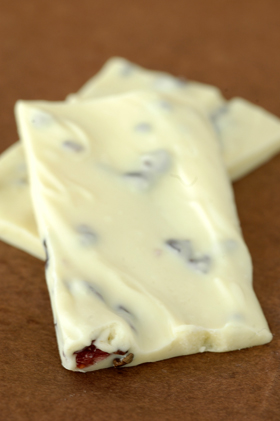

|
Ending
the year... with the Crucible's Nifty Gifty Show is always so much fun. The Crucible itself |
|||
is transformed
into a sort of gritty, industrial-glam holiday palace (my kind of place!),
where roam elves on stilts, Santa on a bicycle and even a strolling
accordionist, who knew just when to break into "The Teddy Bears'
Picnic" to entertain small fry. ...1 pound
good-quality white chocolate This bark
is definitely better than a bite! |
||||
| December 10, 2009 | ||||
 |
Maybe
it's because I have such a short...... ....attention span - I'm sorry, what was I |
|||
talking about.....?
Ok, you get the idea. My latest delvation into audio books is "The
Orchid Thief" by Susan Orlean, and I can't put it down. (and that's
not just because my hands are full of glass already, it's actually quite
fascinating. So far (and I'm only about a third of the way through it)
I want to liken Orlean's style to falling somewhere in between James
Burke's marvelous series of some year back "Connections" and
Melville's "Moby Dick." * More fascinating minutiae about
the plants themselves and the history of orchid collecting and cultivating
than you can shake a stick at. (and if you're not a stick-shaking devotee,
you still stand a pretty good chance of enjoying it.) And, if what you
are hearing doesn't exactly wind your watch, just give it a minute,
and you will be hooked once more. |
||||
| * and, by the way, I did not find the audio version of "Moby Dick" to be nearly as impenetrable as the print version; nay, it was a joy to hear, and kept drawing me back into it night after long night, wow! Many of the passages were pure poetry, except for the fact that they were actually prose (note: Ralph is not such a fan of actual poetry...) I highly recommend it to anyone (like me) that couldn't be bothered with it in high school. | ||||
| December 1, 2009 | ||||
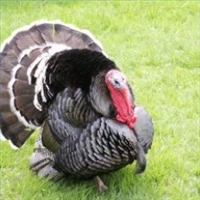 |
(in a low, grim, whispered voice in the back of my head): Listening to a lot of Brother Jack
McDuff... |
|||
| Much stuff to make for upcoming
shows. Why does everything that I make look like it has something
to do with a turkey? I mean, it probably doesn't, really, and yet...... It's sort of like something out of Edgar A. Poe - "The Telltale Turkey", or some such thing. Must be the leftovers, coming back to haunt me. An undigested bit of dressing, perhaps? Or yet another.....yes, just one more serving of that pie..... Leftovers are really my favorite part of the holidays. I'll admit that there is a practical limit, however. Fred Allen once observed that "the definition of 'Eternity' is two people and a ham." That big ol'carcass in the fridge is a really good excuse to invite folks over to help us finish it off. |
||||
| November 21, 2009 | ||||
 |
Not quite
sure.... ...it might be owing to the fact that |
|||
Thanksgiving
is bearing down upon us like a runaway truck full of turkeys, but everything
seems to suggest food. Good food. and not one bite of it on a stick
(see earlier entries, oh yeah.) Ok, at this point Thanksgiving is looking downright tolerable! We wish you and yours the same! |
||||
| November 17, 2009 | ||||
 |
The Deborah
here. Often when I discuss... ... the creative process with others who do art (“the creative process” being an inflated phrase, I guess, for |
|||
| asking others, “So, how
do you do what you do?”), we often talk about the difficulty of
finding time to create. Just like finding time to do anything else, if you make art, you need time not just for production but time to think, dream, try stuff, find out it doesn’t work, try other stuff, find out that doesn’t work but maybe has some redeeming feature that you can use, and finally find your way. Then, of course, there’s the thing that happens when you finally have the time ... but you don’t want to work on the current project. Or you’re suddenly on fire to try something quite different. Or - the worst - you have no ideas or inspiration. Different artists deal with this in different ways: forcing themselves to plow ahead with what’s already on the board, making notes on the new idea and promising themselves they’ll take that up later, or looking through art or costume books for inspiration. In severe cases, maybe they decide their art mission for the day is to go out in the garden, go for a hike or visit a museum. Anything that “untracks” the mind and allows the subconscious to get to work again. Cooking sometimes works, too. Here’s a recipe for butternut squash that we enjoyed last night: BAKED BUTTERNUT SQUASH OK, you do know that when we say “butternut
squash” you can substitute “acorn squash” or really,
any kind of winter squash. 1 butternut squash Preheat the oven to 350 degrees. Cut the squash in half lengthwise (you’ll need a big, sharp knife for this: the shell is tough; and for heaven’s sake, be careful, because it’ll tend to roll on the cutting board ... you do use a cutting board, right? And remember to stay out of your own line of fire - sound advice for most of life, too.). With a sturdy tablespoon or ice cream scoop, scrape out the seeds and squash guts; set aside for roasting later (see end of recipe). Coat the cut sides of the squash with the butter or olive oil, and place the squash halves cut side down in a baking pan. Place in oven and bake for 45-60 minutes. You can tell because the shell will have browned patches on it, but won’t be charred. And you’ll be able to pierce the shell easily with the point of a paring knife. Remove the squash from the oven and let cool a bit. Serve either simply sliced, or puree/mash with a potato masher, adding butter and/or cream. Or drizzle with maple syrup. (If you use maple syrup, also try sprinkling toasted, chopped almonds, hazelnuts or walnuts on it ... yum! Just the aroma of the roasting squash and toasting nuts will drive everyone in your house, well, nuts - buttery or otherwise.) Tips: If you want to make the entire dinner simply, do what we did the other night: In a large roasting pan, bake the squash along with chicken pieces. Dry the chicken really well so the skin will be crispy (that’s a tip from Thomas Keller, owner of the French Laundry in Yountville, Calif.). Season with your favorite seasoning (we like Mrs. Dash) and place skin side up in the pan (the chicken, not Mrs. Dash, poor dear.) Nestle the squash halves next to the chicken and forget about them for about an hour. The chicken should test at 160 degrees in the leg or thigh, and the extra baking time won’t hurt the squash. The chicken fat and juices will flavor the squash, the squash sweetness will make the chicken taste even better. All you need besides this is a green salad, a loaf of sourdough bread and a nice, crisp white wine. Like soup? If you have leftover squash,
it’s still good the next day. But if you want to make a great
soup, do this: Heat 2 tablespoons butter in a large saucepan, and add
1 chopped shallot or 2-3 minced garlic cloves, plus a few springs fresh
thyme (or a teaspoon or so of dried thyme). Let sweat on low heat until
the shallot or garlic is translucent. Puree the cooked squash in a blender
or food processor or with a potato ricer, and add to the butter-shallot
mixture. Add chicken broth (about 2 cups homemade or a can of, um, canned).
Heat through. Serve hot. Enjoy, and appreciate the fact that, while
Winter may sometimes be dreary, you can't have delicious stuff like
this without it! |
||||
| November 12, 2009 | ||||
 |
Been
watching some of the frolicsome denizens... ... of the birdbath out at the edge of the back |
|||
| meadow (we used to laughingly
call it a ‘lawn’ in it’s pre-feral form); jays, orioles
and some of the fattest (and most appreciative) red breasted robins I’ve
ever seen. This causes me to muse about some of the birds I’ve known down through the years. My grandmother always had some sort of strange relationships with birds, be it a caged canary (that she fed bits of hardboiled egg to, which I always considered to be a form of occult cannibalism) that would sweetly sing, or a wild crow (which she dubbed “Poe”) that would ‘defend’ her by attacking visitors’ heads with its feet. (It once knocked my cap about eight feet off of my head with one low Stuka-like pass.) I think that my favorite was her bird “Jasper,” some class of conure and, ultimately, her last. Jasper was kept in a reasonably-sized cage that my grandmother would carry with her about her small house while doing various chores. For some weeks my grandmother, who we suspected was edging on toward dottiness, bragged about how Jasper had learned to throw his voice, and was tickled to no end about it. One day just after Halloween, as I popped in on her on the way to the grocery store to see if she needed anything, she once more gushed with the news of how her bird had, just that very minute, thrown his voice all the way back to the bedroom from the kitchen where his cage now sat. “And when he’s here in the bedroom, he can throw his voice all the way to the kitchen!” I assured her that this was a truly singular specimen. Right about then I heard the unmistakable sound of the smoke alarm from down the hallway connecting the bedroom and kitchen, giving its “my battery needs changing” chirp, followed immediately by the bird answering it with perfectly imitated chirps. “See there!” she exclaimed with a look of great significance and pride. “Wow, Grandma,” I inquired, “how long has he been doing this wonderful trick of his?” “Gosh, I can’t exactly remember, but it’s been at least several months,” she replied, its significance giving me chills. The bird/alarm call-and-response repeated for several cycles before I departed. When I returned from the grocery store with her basket of goodies (yep, just like in the fairy tales) I surreptitiously installed the long-needed new battery in the smoke detector while she busied herself in the kitchen putting away her boxes of whipped dessert toppings, cartons of Dr. Pepper (a favorite of Jasper’s, too), birdseed and other such essentials. When she walked out to the living room, she found me sitting next to Jasper’s cage and speaking to him in earnest. “Now Jasper, I know that you’re a really smart, talented bird. It’s because you’re so smart that I know that you will understand me when I tell you this. I’ll bet that you’re so smart that you can go all the way until next Halloween before you throw your voice again. Can you do that? Yep, I thought so. You’re terrific! Keep up the great work.” And, for the rest of her days, my grandmother would brag about her bird that was so smart that he could not only throw his voice, but could understand english and follow instructions, too. |
||||
 |
||||